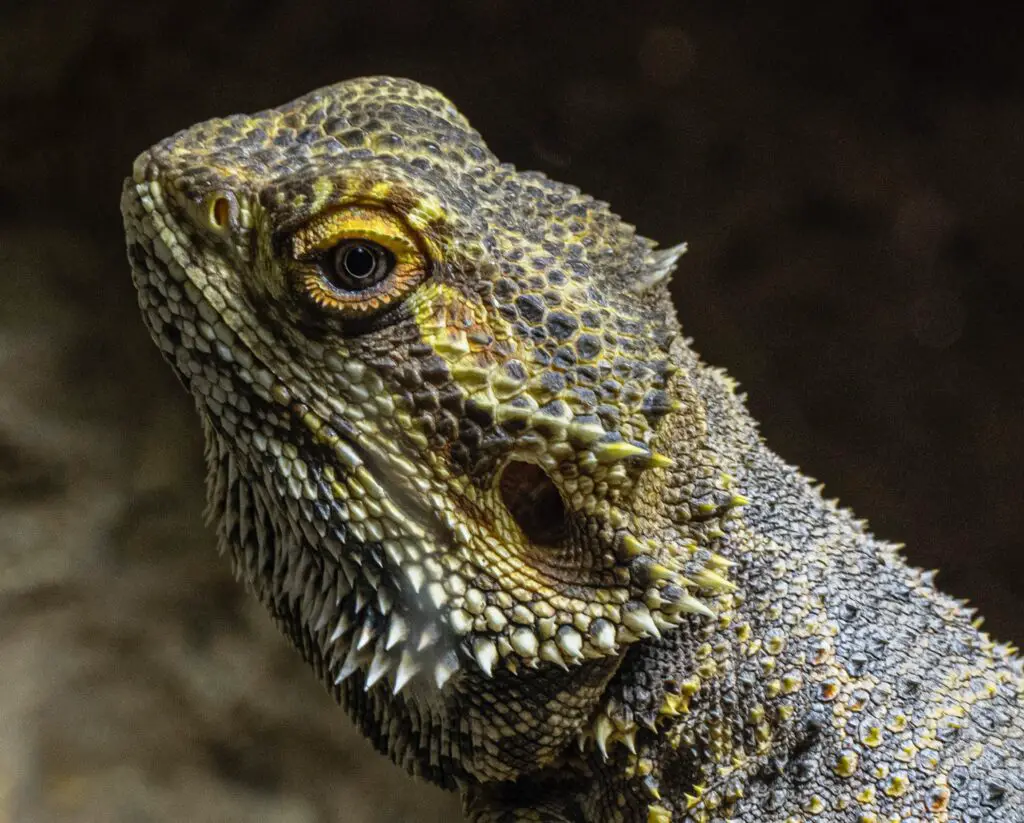Why is my bearded dragon running around like crazy
Why is my bearded dragon running around like crazy: Bearded dragons, with their captivating appearance and intriguing behavior, have become popular pets among reptile enthusiasts. These reptiles, scientifically known as Pogona vitticeps, are native to the arid regions of Australia.
Bearded dragons belong to the family Agamidae and are known for their distinctive features like a triangular-shaped head, scaly skin, and most notably, their “beard” – a prominent flap of skin under their chin that expands when they feel threatened or excited. These fascinating creatures have won the hearts of many pet owners due to their docile nature and relatively low maintenance requirements compared to other reptiles.
Bearded dragons can make wonderful companions for both experienced reptile keepers and beginners alike. Their calm demeanor and unique behaviors make them a delight to observe and interact with.
Brief overview of bearded dragons as pets
Bearded dragons have gained popularity as household pets due to their adaptability to captive environments and relatively easy care requirements. They are diurnal creatures, meaning they are active during the day and sleep at night. This aligns well with human routines, making them great companions for those seeking interactive pets that are awake during typical waking hours.
These reptiles have a lifespan of 10-15 years when provided with proper care. They can grow up to 18-24 inches in length from head to tail tip.
Bearded dragons require spacious enclosures with specific temperature gradients ranging from 95°F (35°C) basking spots down to cooler areas around 75°F (24°C). Additionally, they need access to UVB lighting for proper calcium metabolism and overall good health.
Introducing the intriguing behavior. Why is my bearded dragon running around like crazy
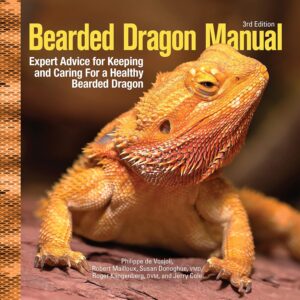 While bearded dragons are generally known for their calm and relaxed disposition, it is not uncommon to witness them engaging in seemingly frantic behavior, running around their enclosure with great energy and speed. This peculiar behavior can be surprising and leave pet owners wondering about the reasons behind such antics. The sight of a bearded dragon darting back and forth, climbing on rocks or branches, and occasionally bobbing its head up and down can both amaze and confuse observers.
While bearded dragons are generally known for their calm and relaxed disposition, it is not uncommon to witness them engaging in seemingly frantic behavior, running around their enclosure with great energy and speed. This peculiar behavior can be surprising and leave pet owners wondering about the reasons behind such antics. The sight of a bearded dragon darting back and forth, climbing on rocks or branches, and occasionally bobbing its head up and down can both amaze and confuse observers.
This running around like crazy behavior is often seen during specific instances or environmental conditions that trigger heightened levels of excitement or anxiety in these reptiles. Understanding the possible causes behind this behavior can help pet owners provide appropriate care and ensure the well-being of their beloved bearded dragons.
Understanding Bearded Dragons
Physical characteristics and natural behaviors
Bearded dragons are fascinating creatures with a unique set of physical characteristics that make them stand out in the reptile world. They typically have a stout body covered in rough, scaly skin, with a triangular-shaped head and a row of spiky scales that resemble a beard when puffed up.
The coloration of their skin can vary greatly, ranging from earthy tones to vibrant hues such as oranges, reds, and yellows, allowing them to blend into their natural surroundings. In terms of size, adult bearded dragons usually measure around 18 to 24 inches in length from head to tail.
Their bodies are streamlined and muscular, enabling them to move swiftly across various terrains. These reptiles possess strong limbs with sharp claws, which they use for climbing and digging.
In the wild, bearded dragons are native to the arid regions of Australia. Their natural habitat primarily consists of deserts, grasslands, and woodlands.
These areas offer plenty of rocks, branches, and burrows for shelter. Bearded dragons are diurnal creatures (active during the day), basking under the warm sun on rocks or elevated surfaces to regulate their body temperature effectively.
Their native habitat and lifestyle in the wild
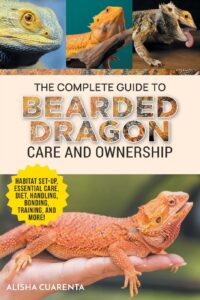 Living among Australia’s vast terrains has shaped bearded dragons’ behavior patterns over millions of years. In their natural habitat, these reptiles lead an active lifestyle centered around finding food resources while avoiding predators. Bearded dragons are opportunistic omnivores with a diverse diet consisting mainly of insects such as crickets or roaches.
Living among Australia’s vast terrains has shaped bearded dragons’ behavior patterns over millions of years. In their natural habitat, these reptiles lead an active lifestyle centered around finding food resources while avoiding predators. Bearded dragons are opportunistic omnivores with a diverse diet consisting mainly of insects such as crickets or roaches.
However, they also consume vegetables like leafy greens and occasionally small rodents or other lizards when available. This dietary flexibility allows them to adapt successfully to varying food availability throughout different seasons.
Their survival heavily relies on thermoregulation, a process that involves maintaining their body temperature within an optimal range. In the wild, bearded dragons utilize their surrounding environment to achieve this balance.
They bask in the sun during cooler mornings to warm up and seek shade during peak heat periods to prevent overheating. Furthermore, bearded dragons are known for their fascinating communication techniques.
They use a combination of visual displays, postures, and head-bobbing movements to communicate with others of their kind. This behavior helps establish dominance hierarchies and facilitate courtship rituals during the breeding season.
Understanding these aspects of bearded dragon biology provides insight into their instinctual behaviors and can help us interpret unusual or erratic actions when observed in captivity. By simulating their natural habitat as closely as possible, we can ensure these remarkable reptiles thrive in our care as well.
Normal Behaviors of Bearded Dragons
Daily activities and movements
Bearded dragons, or Pogona vitticeps, are diurnal reptiles which means they are primarily active during the day. In their natural habitat of arid regions in Australia, these magnificent creatures engage in a variety of daily activities to meet their physiological and behavioral needs. One of the most essential aspects of their routine is thermoregulation.
Bearded dragons rely on basking to regulate their body temperature, utilizing external heat sources such as rocks or branches to absorb warmth from the sun. They spend several hours basking in order to raise their body temperature for proper digestion and overall metabolic functioning.
Typical basking, hunting, and resting patterns
Basking is crucial for bearded dragons as it allows them to metabolize nutrients effectively and maintain optimal health. After absorbing sufficient heat, they engage in another vital activity: hunting for food. Bearded dragons are omnivorous and have a varied diet consisting of insects such as crickets and mealworms, as well as leafy greens and fruits.
Their hunting behavior involves stalking prey with precision before capturing it with a quick slingshot-like motion of their tongue. Once their belly is full, bearded dragons will often find a comfortable spot within their enclosure for rest.
They prefer a peaceful environment free from disturbances during this time. Resting helps them conserve energy while allowing for proper digestion to take place.
Regular exploration within their enclosure
Bearded dragons are known explorers within their enclosures or terrariums. These intelligent creatures possess an innate curiosity that drives them to investigate every nook and cranny in search of potential resources or stimuli.
Furthermore, exploration provides mental stimulation necessary for maintaining behavioral health. During these expeditions around the enclosure, bearded dragons may climb on rocks, bask under heat lamps, or interact with various objects.
This behavior also helps them establish a sense of territoriality, as they mark their presence through scent glands located on their femoral pores. Regular exploration is not only an instinctual activity but also contributes to their overall well-being and emotional enrichment.
Understanding these normal behaviors of bearded dragons is crucial in order to differentiate between typical daily activities and abnormal hyperactive behaviors. By observing their basking, hunting, resting patterns, and regular exploration within their enclosure, owners can better discern any changes in behavior that may require further investigation or intervention.
Possible Reasons for Running Around Like Crazy
Environmental Factors Affecting Behavior
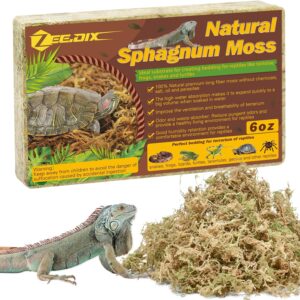 When observing a bearded dragon running around like crazy, one of the primary factors to consider is the environment in which they are housed. Temperature fluctuations within their enclosure can significantly impact their behavior and overall well-being. Bearded dragons are ectothermic creatures, meaning they rely on external heat sources to regulate their body temperature.
When observing a bearded dragon running around like crazy, one of the primary factors to consider is the environment in which they are housed. Temperature fluctuations within their enclosure can significantly impact their behavior and overall well-being. Bearded dragons are ectothermic creatures, meaning they rely on external heat sources to regulate their body temperature.
It is crucial to provide them with a thermal gradient in their habitat, allowing them to move between warmer and cooler areas as needed. The ideal temperature range for bearded dragons is typically between 95°F (35°C) and 105°F (40°C) on the basking spot and around 80°F (27°C) at the cooler end.
Inadequate heating or cooling within the enclosure can lead to discomfort or stress in bearded dragons. If the temperatures are too cold, they may become sluggish and less active.
Conversely, if it’s too hot or if there are sudden temperature spikes, it can cause distress and make them restless. This can result in hyperactive behavior such as running around excessively.
It is essential to monitor and maintain proper temperatures within their habitat using accurate thermometers and suitable heat sources. The lighting conditions in a bearded dragon’s enclosure also play a significant role in their activity levels.
Proper UVB lighting is crucial for these reptiles as it aids in vitamin D synthesis, which helps metabolize calcium effectively. Insufficient exposure to UVB rays can result in inadequate calcium absorption, leading to various health issues such as metabolic bone disease (MBD).
In turn, MBD can cause muscle weakness or pain that may manifest as erratic behavior like continuous running or excessive movement. Therefore, providing appropriate UVB lighting that covers an adequate portion of their habitat is paramount for maintaining their overall well-being.
Physical Health-Related Causes
Erratic behavior in bearded dragons may also stem from underlying physical health issues. Parasites or infections, such as coccidia or gastrointestinal worms, can affect their digestion and overall comfort. These conditions can cause discomfort and irritability, leading to unusual hyperactivity or restlessness.
Regular veterinary check-ups and fecal examinations are crucial to detect and treat such health concerns promptly. Metabolic bone disease (MBD) is another common ailment that can contribute to erratic behavior in bearded dragons.
MBD occurs when there is an imbalance in calcium, phosphorus, and vitamin D3 levels within their bodies. Inadequate calcium intake or improper UVB exposure impairs calcium absorption, resulting in weakened bones and muscles.
This weakness can cause pain during movement or exertion, causing them to exhibit running around like crazy behavior. A balanced diet supplemented with calcium and appropriate UVB lighting are essential preventive measures against the development of MBD.
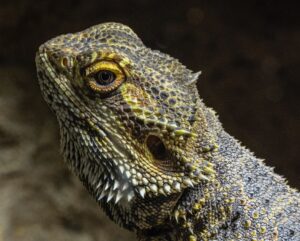
Behavioral Factors Influencing Activity Levels
Stressors within a bearded dragon’s environment can trigger hyperactive behavior as they react to changes around them. For instance, introducing new additions to their enclosure, such as decorations or rearranging existing elements, can disrupt their sense of familiarity and security.
This disturbance may cause them to respond by running around excessively in an attempt to explore and assess the altered surroundings. The presence of other pets in the household can also influence a bearded dragon’s activity levels.
The sight or smell of other animals may elicit feelings of anxiety or territorial instincts within them. This reaction might lead them into a heightened state of hyperactivity as they try to establish dominance within their perceived territory.
Understanding these behavioral factors is vital for creating a suitable environment that minimizes stressors for your pet bearded dragon. Ensuring a consistent and predictable habitat will help promote calmness and reduce excessive running behaviors associated with environmental changes or the presence of other animals.
Tips for Addressing Hyperactivity in Bearded Dragons
Providing a Calming Environment
Creating a peaceful and stress-free environment is essential for managing hyperactivity in bearded dragons. Start by ensuring that their enclosure is spacious, well-maintained, and equipped with appropriate hiding spots.
Add natural elements such as rocks, branches, or plants to mimic their natural habitat and provide a sense of security. Additionally, consider placing the enclosure in a quiet area of your home to minimize disturbances.
Maintaining optimal temperature and lighting conditions is crucial for the well-being of your bearded dragon. Use a thermometer to monitor the temperature gradients within the enclosure accurately.
Provide a warm basking spot with temperatures between 95-105°F (35-40°C) and maintain ambient temperatures around 80°F (27°C). A consistent light cycle with UVB lighting is also essential for their physical and mental health.
Implementing a Balanced Diet
A nutritious diet plays a significant role in regulating your bearded dragon’s activity levels. Ensure they have access to fresh vegetables like dark leafy greens (e.g., kale, collard greens) along with occasional fruits and vegetables high in vitamin A content (e.g., carrots).
Offer appropriate protein sources such as live insects (e.g., crickets, mealworms) but avoid an excess of fatty treats like waxworms. Supplementation is vital to prevent nutritional deficiencies that can contribute to hyperactivity.
Calcium powder should be dusted on their food at least three times per week, while multivitamin supplements can be given once or twice per week. Remember to follow recommended dosages based on age and weight.
Establishing Routine Care
 Consistency is key when it comes to managing hyperactivity in bearded dragons. Establishing daily routines helps them feel secure and reduces stress.
Consistency is key when it comes to managing hyperactivity in bearded dragons. Establishing daily routines helps them feel secure and reduces stress.
Stick to a regular feeding schedule, ensuring that meals are offered around the same time each day. Additionally, maintain a consistent daily light cycle, replicating natural day and night patterns.
Regular handling and socialization are also important for your bearded dragon’s well-being. However, be mindful of their individual preferences and limits.
Some dragons may enjoy gentle interaction while others may prefer observing their surroundings from a distance. Pay attention to their body language and respect their boundaries to avoid causing additional stress.
To sum up why is my bearded dragon running around like crazy
Understanding why your bearded dragon is running around like crazy requires considering various factors such as environmental conditions, physical health, and behavioral triggers. By providing a calming environment with appropriate temperature and lighting conditions, you can support their overall well-being while reducing hyperactivity.
A balanced diet rich in nutrients along with routine care routines will further promote a sense of security for your beloved reptilian companion. Remember that every bearded dragon is unique, so it’s crucial to observe their behavior closely and make adjustments accordingly.
With proper care and attention to their needs, you can help them lead happy and fulfilling lives as cherished pets in your household. Embrace the joy of being a responsible caregiver as you witness the fascinating behavior of your energetic bearded dragon thriving in its environment.
Further Reading:
- Carolina Custom Cages Terrarium Review
- 8 Best Basking Rocks for Beardie: What Is the Best Choice?
- 10 Best Thermometers for Beardie: How to Choose the Best One?
- 5 Best Beardie Lighting Setups for Beardie Lovers
- 9 Best Heat Lamps for Beardie: Natural Habitat Provided

